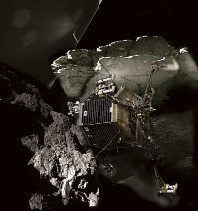 The first probe ever to land on the surface of a comet performed some serious science before going into hibernation. Europe’s Philae lander found organic molecules in the comet’s atmosphere and discovered that the frigid object’s surface is as hard as ice.
The first probe ever to land on the surface of a comet performed some serious science before going into hibernation. Europe’s Philae lander found organic molecules in the comet’s atmosphere and discovered that the frigid object’s surface is as hard as ice.
The European Space Agency’s Philae became the first probe to softly land on the face of a comet. After being released from the Rosetta orbiter, the lander actually bounced off Comet 67P/Churyumov-Gerasimenko twice before coming to its current less-than-ideal resting spot. Because of the low sunlight conditions, Philae went into hibernation after only about 57 hours on the comet when its primary batteries depleted. But the probe still beamed back a wealth of science during its short initial life on the icy body.
While it will take scientists a while to sift through the data collected by Philae, it looks like the probe has sent home some interesting new results. Before shutdown, one of Philae’s instruments managed to ‘sniff’ the first organic molecules detected in the atmosphere of the comet, officials with the DLR German Aerospace Centre said. However, scientists still aren’t sure what kind of organics — carbon-containing molecules that are the building blocks of life on Earth — were found.
No contact will be possible unless maneuvers by controllers on the ground nudge Philae back into a sunnier spot. On its third and final landing, it unfortunately came to rest in the shadow of one of the comet’s many cliffs. Contrary to earlier reports (or speculations), Valentina Lommatsch from the German Aerospace Centre explained that all three of Philae’s legs are on the ground. But the lander appears to be tipped up at an angle because one of the scenes from the panorama (below) shows mostly sky.











